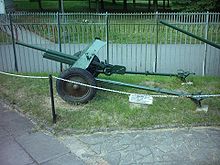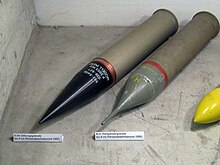Anti-tank gun

An anti-tank cannon ( Pak or PaK for short ) is a cannon designed for fighting armored targets, especially tanks . The anti-tank gun is used to fire armor-piercing ammunition with direct aiming .
development
The development of these weapons became necessary after the first tank operations of the First World War in order to have a suitable defense weapon against tanks . Initially, the tanks were fought in direct fire with conventional artillery pieces . However, it quickly became apparent that these were only suitable to a limited extent for anti-tank combat and that a corresponding weapon had to be developed.
Between the world wars , anti-tank rifles were initially developed and introduced as super-heavy rifles. With the increasing thickness of the armor, these weapons were no longer sufficient, so special anti-tank guns were developed.
The Maginot Line - it was built in the 1930s - was poorly equipped with only 344 guns and 500 anti-tank guns (based on its total length).
In the Second World War, this weapon had her wedding, as the anti-tank played an increasingly important role. Pak were used in various designs on all fronts.
At the beginning of the war, the German Wehrmacht was equipped with the 3.7 cm PaK 35/36 . At the beginning of the war, however, this gun proved to be underperforming. In the course of the war, the increasingly stronger armor of the tanks also required more powerful anti-tank guns. As a result, anti-tank guns with calibers of 5 cm ( PaK 38 ), 7.5 cm ( PaK 40 ), 8.8 cm ( PaK 43 ) and 12.8 cm ( PaK 44 ) were developed in the German Reich . Even the performance of the 7.5 cm Pak 40 was no longer sufficient on the Eastern Front at the end of the war to cope with the latest generation of Soviet tanks.
For the Wehrmacht it turned out to be a stroke of luck that the 8.8 cm FlaK (an anti-aircraft gun with 8.8 cm caliber), unlike most other heavy anti-aircraft guns, could also be aimed below the horizontal and thus also shoot targets directly on the ground could ( ground combat ). As part of the campaign in the west , Allied tanks under General Weygand attacked German lines in the Battle of Abbeville (May 28 to June 4, 1940) . It turned out that only the "Acht-Acht" could penetrate the armor of the heavy British Matilda II tanks . The 57th Infantry Division managed to stop the advance.
The weight of the anti-tank gun increased considerably in the course of the war; therefore they needed ever more powerful tractors. Up to the 5 cm Pak 38, 1 ton traction devices were used. The 7.5 cm Pak 40 required a light 3-ton artillery tractor from Hansa-Lloyd-Goliath, later Borgward , and the 8.8 cm Pak needed a large tractor ( Sd.Kfz. 7 ), the 12, 8 cm Pak was with Sd.Kfz. 7 can only be moved insufficiently, the Sd.Kfz. 9 (Famo-18-t-) tractor was rare. The effective 8.8 cm and 12.8 cm PaK were therefore supplemented by recoilless rocket launchers. The 8 cm anti-tank launchers 600 and 8.8 cm rocket launcher 43 (Puppchen) were smaller, lighter, manoeuvrable and could be used by two to three men. Their armor-piercing effect was limited to distances of up to 500 meters.
To increase mobility, many anti-tank guns were therefore placed on self-propelled guns , for example Marder II . In addition, tank destroyers were developed for mobile anti-tank defense , for example the very successful Jagdpanther , the clumsy Jagdtiger and the light Jagdpanzer 38 (t) .
The anti-tank guns were grouped in the Wehrmacht in tank destroyer units, which were set up as 14th company in the infantry regiments , existed in the divisions as an anti-tank department (around 105 men) or as a heavy anti-tank department were subordinate to the corps or the army .
Towards the end of the Second World War, recoilless cannons were developed which, after the Second World War, initially supplemented and partially replaced the previously common anti-tank cannons , but could not establish themselves in the long term.
In the armed forces of the Warsaw Pact , rifled anti-tank guns (such as the 100 mm M 1955 or the 85 mm D 44) were still used until the 1980s. Some states still use this today.
Today, anti-tank guns in infantry use have been almost completely replaced by anti-tank missiles ( TOW , MILAN etc.) and rocket grenades ( e.g. RPG ).
List by country of manufacture
German Empire
- 3.7-cm TAK
- 3.7 cm PaK 35/36
- 4.2 cm light PaK 41
- 5 cm PaK 38
- 7.5 cm PaK 97/38
- 7.5 cm PaK 40
- 8.8 cm PaK 43 & Pak 43/41
- 12.8 cm PaK 44
France
- Canon léger de 25 antichar SA-L mle 1937 also as 2.5 cm PaK 113 (f)
- Canon de 47 antichar SA mle 1937 47 mm
- Canon de 47 antichar SA mle 1939 47 mm
Great Britain
- QF 2 pounder (40 mm)
- QF 6 pounder (57 mm)
- QF 17 pounder (76.2 mm)
- 120mm BAT, L6 wombat
Japan
- Model 96 25 mm
- Type 1 37 mm
- Type 1 47 mm
Sweden
- Bofors 37mm PaK
- Pvpj 1110 90 mm
Soviet Union
- 37 mm 1-component
- 45 mm anti-tank gun M1937 (53-K)
- 45 mm anti-tank gun M1942
- 57 mm anti-tank gun ZiS 2
- 76mm division cannon M1942 (SiS-3)
- 85 mm anti-tank gun D-48
- 100 mm anti-tank gun T-12 (2A19)
- 100 mm anti-tank gun MT-12 (2A29)
- 125 mm anti-tank gun 2A45M Sprut-A
- 82mm recoilless gun B10 (RG-82)
- 107mm recoilless gun B11 (RG-107)
Czechoslovakia
United States
- 37mm M 3
- 3-inch M 1918
- M40 recoilless gun
- 90 mm M1 gun
literature
- Werner Haupt : weapon arsenal - anti-tank guns. 3.7 cm - 5.0 cm - 7.5 cm - 8.8 cm - Pak - without self-propelled guns. Volume 117, Podzun-Pallas Verlag, ISBN 3-7909-0360-4 .
- Hand flour: field, anti-tank and anti-aircraft cartillery. Mittler & Sohn, ISBN 3-8132-0827-3 .
- Weapons arsenal - 3.7 cm tank destroyer cannon. Volume 169, Podzun-Pallas Verlag, ISBN 3-7909-0619-0 .
- Weapons arsenal - the 5 cm tank destroyer cannon. Volume 170, Podzun-Pallas Verlag, ISBN 3-7909-0627-1 .
- Gordon L. Rottman: World War II Infantry Anti-Tank Tactics Osprey Publishing, 2005, page 47, ISBN 978-1-84176-842-7 . (67 pages online PDF) ( Memento from May 15, 2018 in the Internet Archive )








